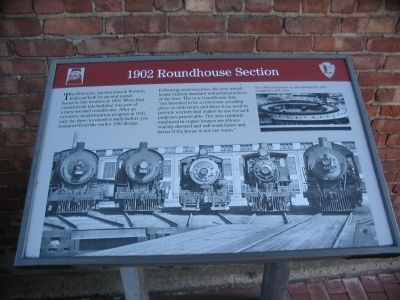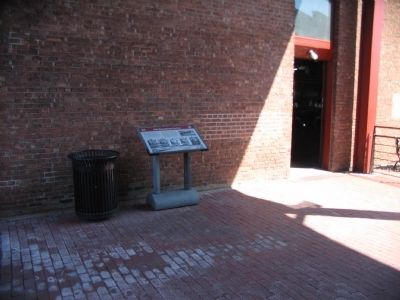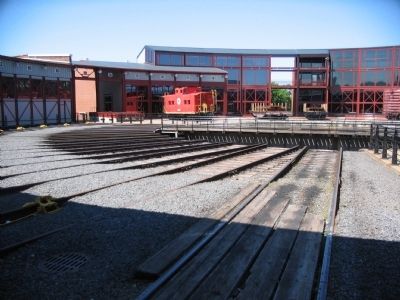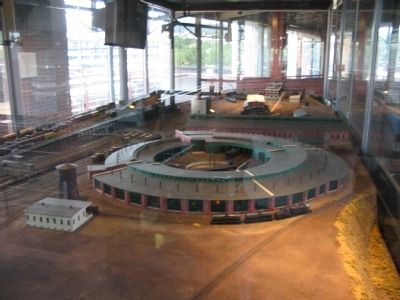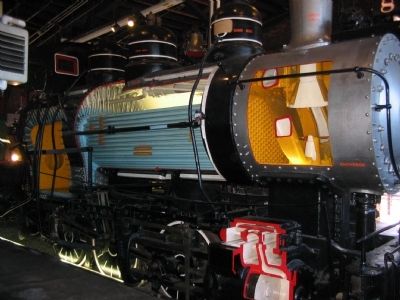Scranton in Lackawanna County, Pennsylvania — The American Northeast (Mid-Atlantic)
1902 Roundhouse Section
Inscription.
The Delaware, Lackawanna & Western Railroad built its second roundhouse in this location in 1902. When first constructed, this building was part of a forty-six-stall roundhouse. After an extensive modernization program in 1937, only the three locomotive stalls before you remained from the earlier 1902 design.
Following modernization, the new roundhouse utilized industrial practices of the time. The new roundhouse was "not intended to be a rest room, a loafing place or club room, and there is no need to provide warmth that makes its use for such purposes practicable. The men regularly employed in engine houses are always warmly dressed and will work faster and better if the house is not too warm."
Erected by Steamtown Nataionl Historic Site - National Park Service.
Topics. This historical marker is listed in this topic list: Railroads & Streetcars. A significant historical year for this entry is 1902.
Location. 41° 24.439′ N, 75° 40.247′ W. Marker is in Scranton, Pennsylvania, in Lackawanna County. Marker can be reached from Mechanic Street, on the right when traveling east. Located in the Roundhouse in Steamtown National Historic Site. Touch for map. Marker is in this post office area: Scranton PA 18503, United States of America. Touch for directions.
Other nearby markers. At least 8 other markers are within walking distance of this marker. E.J. Lavino & Company #3 (a few steps from this marker); New Haven Trap Rock Company #43 (within shouting distance of this marker); Turntable (within shouting distance of this marker); Long Island Railroad #193 Rotary Snow Plow (within shouting distance of this marker); DL&W Coal Hoppers (within shouting distance of this marker); Claremont & Concord Snow Plow #60 (within shouting distance of this marker); Pennsylvania Boxcars (within shouting distance of this marker); 1902/1937 Roundhouse (within shouting distance of this marker). Touch for a list and map of all markers in Scranton.
Also see . . . Steamtown National Historic Site. National Park Service site. (Submitted on June 13, 2009, by Craig Swain of Leesburg, Virginia.)
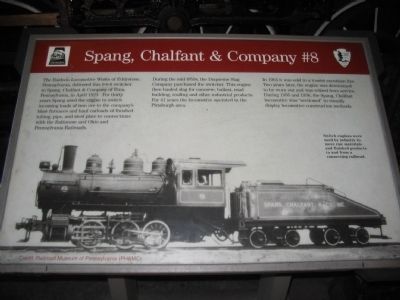
Photographed By Craig Swain, July 25, 2008
6. Spang, Chalfant & Company #8
The cutaway engine's interpretive marker (indoor):
The Baldwin Locomotive Works of Eddystone, Pennsylvania, delivered this 0-6-0 switcher to Spang, Chalfant & Company of Etna, Pennsylvania, in April 1923. For thirty years Spang used the engine to switch incoming loads of iron ore to the company's blast furnaces and haul carloads of finished tubing, pipe, and steel plate to connections with the Baltimore and Ohio and Pennsylvania Railroads.
During the mid-1950s, the Duquesne Slag Company purchased the switcher. This engine then hauled slag for concrete, ballast, road building, roofing and other industrial products. For 41 years the locomotive operated in the Pittsburgh area.
In 1964 it was sold to a tourist excursion line. Two years later, the engine was determined to be worn out and was retired from service. During 1995 and 1996, the Spang, Chalfant locomotive as "sectioned" to visually display locomotive construction methods.
The Baldwin Locomotive Works of Eddystone, Pennsylvania, delivered this 0-6-0 switcher to Spang, Chalfant & Company of Etna, Pennsylvania, in April 1923. For thirty years Spang used the engine to switch incoming loads of iron ore to the company's blast furnaces and haul carloads of finished tubing, pipe, and steel plate to connections with the Baltimore and Ohio and Pennsylvania Railroads.
During the mid-1950s, the Duquesne Slag Company purchased the switcher. This engine then hauled slag for concrete, ballast, road building, roofing and other industrial products. For 41 years the locomotive operated in the Pittsburgh area.
In 1964 it was sold to a tourist excursion line. Two years later, the engine was determined to be worn out and was retired from service. During 1995 and 1996, the Spang, Chalfant locomotive as "sectioned" to visually display locomotive construction methods.
Credits. This page was last revised on June 16, 2016. It was originally submitted on June 13, 2009, by Craig Swain of Leesburg, Virginia. This page has been viewed 1,248 times since then and 26 times this year. Photos: 1, 2, 3, 4, 5, 6. submitted on June 13, 2009, by Craig Swain of Leesburg, Virginia.
